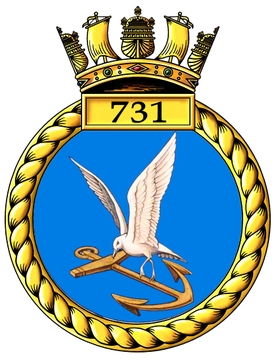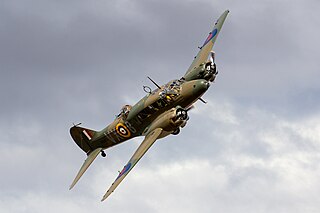Related Research Articles
714 Naval Air Squadron was a squadron of the Royal Navy's Fleet Air Arm. It was first formed as 714 (Catapult) Flight on 15 July 1936, by renumbering 406 (Catapult) Flight, and operated Fairey IIIF floatplanes from cruisers in the East Indies. The Fairey IIFs were quickly replaced by Hawker Osprey floatplanes and Supermarine Walrus flying boats, and in 1937 these were supplemented by Fairey Seafox floatplanes. By July 1938 it had consolidated on the Walrus as equipment, and in early 1939 it was upgraded to full squadron status. It was disbanded on 21 January 1940, when all the Fleet Air Arm's catapult units were merged to form 700 Naval Air Squadron.

819 Naval Air Squadron was a Naval Air Squadron of the Royal Navy's Fleet Air Arm.

710 Naval Air Squadron was a Naval Air Squadron of the Royal Navy's Fleet Air Arm.
713 Naval Air Squadron was a Naval Air Squadron of the Royal Navy's Fleet Air Arm.

717 Naval Air Squadron was a Naval Air Squadron of the Royal Navy's Fleet Air Arm which last disbanded in March 1946. It formed as a Torpedo Bomber Reconnaissance Training Squadron, at HMS Owl, RNAS Fearn, in July 1944, operating with Fairey Barracuda torpedo bomber aircraft. The squadron then moved to HMS Merganser, RNAS Rattray, in the October, continuing in Torpedo Bomber Reconnaissance training. In early 1946 the squadron received Blackburn Firebrand aircraft, with the objective of forming a Firebrand Conversion Unit, but this was never realised.

730 Naval Air Squadron was a Naval Air Squadron of the Royal Navy's Fleet Air Arm. It was active between 1944 and 1945 as a Communications Squadron. The squadron was formed and operated out of RNAS Abbotsinch from April to November 1944, by that point in time it operated four types of aircraft. It moved to RNAS Ayr and while there gained two more aircraft types. For the first three months of 1945 a detachment operated out of RNAS Machrihanish, however, the squadron remained at RNAS Ayr until disbanding in August 1945.

731 Naval Air Squadron was a Naval Air Squadron of the Royal Navy's Fleet Air Arm (FAA). It was active between 1943 and 1945 and its sole role throughout its formation was a Deck Landing Control Officer training squadron. Through this role the squadron pilots were nicknamed 'Clockwork Mice'. It was based out of the purpose built airbase, commissioned as HMS Peewit, known as Royal Naval Air Station East Haven, in Scotland, as part of the Deck Landing Training School there.
735 Naval Air Squadron was a Naval Air Squadron of the Royal Navy's Fleet Air Arm. It was active from 1943 as an ASV Radar Training Unit. Forming at HMS Nightjar, at RNAS Inskip, Lancashire, in 1944 the squadron moved to HMS Ringtail, RNAS Burscough, also in Lancashire. Various flights from the squadron moved on to form other Naval Air Squadrons, with the squadron eventually disbanding in 1946.

741 Naval Air Squadron was a Naval Air Squadron of the Royal Navy's Fleet Air Arm which last disbanded during November 1947. It was initially active, between March 1943 and March 1945 as an Observer Training Squadron at HMS Condor, RNAS Arbroath, Scotland, as part of the No. 2 Observer Training School. It reformed at HMS Vulture, RNAS St. Merryn, England, as an Operational Flying Training Unit in August 1946.

743 Naval Air Squadron was a naval air squadron of the Royal Navy's Fleet Air Arm. It was active from March 1943 to March 1945 as a Telegraphist Air Gunner Training Squadron, part of No. 2 Telegraphist Air Gunner School based at R.N. Air Section Yarmouth, Canada.

747 Naval Air Squadron was a Naval Air Squadron of the Royal Navy's Fleet Air Arm which last disbanded in December 1945. 747 Naval Air Squadron was part of the Torpedo Bomber Reconnaissance Pool and formed at HMS Owl, RNAS Fearn, in March 1943, evolving into an Operational Training Unit. July saw the squadron move to HMS Nightjar, RNAS Inskip and became part of No. 1 Naval Operational Training Unit. It returned to HMS Owl in January 1944 and then to HMS Urley, RNAS Ronaldsway, in July. In November 1945 the squadron headquarters moved to HMS Jackdaw, RNAS Crail, leaving a Flight at HMS Urley.

753 Naval Air Squadron was a Naval Air Squadron of the Royal Navy's Fleet Air Arm. It was active as an Observer Training Squadron from 1939 to 1946 as part of No. 2 Observer School, forming out of the School of Naval Co-operation RAF, in May 1939. Initially at RNAS Lee-on-Solent, the squadron moved to RNAS Arbroath just over one year later in August 1940, following a German bombing attack on the air station. It spent four years operating out of Arbroath, before relocating again, this time to RNAS Rattray, where the squadron disbanded in August 1946.

785 Naval Air Squadron was a Naval Air Squadron of the Royal Navy's Fleet Air Arm which disbanded in early 1946. 785 NAS formed as a Torpedo Bomber Reconnaissance Training Squadron, at HMS Jackdaw, RNAS Crail, in November 1940. Throughout its existence it operated a number of various types of torpedo bomber aircraft. The squadron became part of No. 1 Naval Operational Training Unit in late 1944.

786 Naval Air Squadron was a Naval Air Squadron of the Royal Navy's Fleet Air Arm which last disbanded in late 1945, absorbed by 785 Naval Air Squadron. 786 NAS formed at HMS Jackdaw, RNAS Crail, in November 1940, as a Torpedo Bomber Reconnaissance squadron. It operated a few different types of torpedo bomber aircraft, initially equipped with Fairey Albacore and shortly afterwards joined by Fairey Swordfish, these aircraft were replaced by Fairey Barracuda at the of 1942.

788 Naval Air Squadron was a Naval Air Squadron of the Royal Navy's Fleet Air Arm which last disbanded during June 1945. The squadron formed at RN Air Section China Bay in Ceylon, in January 1942, as the British Eastern Fleet's Torpedo Bomber Reconnaissance Pool, however it lost half its strength during the heavy raids by Japanese carrier-borne aircraft in the April. The squadron regrouped at RNAS Tanga in Tanganyika, East Africa to become a Fleet Requirements Unit and relocating almost immediately to RN Air Section Port Reitz, in Mombasa, where it remained operational for the next three years.

789 Naval Air Squadron was a Naval Air Squadron of the Royal Navy's Fleet Air Arm which disbanded in November 1945. 789 Naval Air Squadron formed as a Fleet Requirements Unit at RNARY Wingfield in South Africa, at the beginning of July 1942. It initially only had a single Supermarine Walrus, needing to borrow other aircraft types. 1943 saw the squadron sharing and holding aircraft for other Fleet Air Arm units and it wasn’t until 1944 it started to receive a notable number of its own aircraft.

793 Naval Air Squadron was a Naval Air Squadron of the Royal Navy's Fleet Air Arm which disbanded during October 1945. It was formed in October 1939 at RNAS Ford, as an Air Towed Target Unit, as part of No.1 Observer School. From 1940 to disbandment it operated at RNAS Piarco , Trinidad.

797 Naval Air Squadron was a Naval Air Squadron of the Royal Navy's Fleet Air Arm which last disbanded in October 1945 in Ceylon. Its role was a Fleet Requirements Unit which formed at HMS Ukussa, Royal Naval Air Station Katukurunda, in Ceylon, in July 1942. The squadron moved to RNAS Colombo Racecourse in October 1943. It had a Communications Flight which became 742 Naval Air Squadron in December 1943 and the following summer it had an ‘X’ Flight deployed for target towing for a couple of gunnery schools in Bombay, India and which eventually moved to 722 Naval Air Squadron.
1770 Naval Air Squadron was a Naval Air Squadron of the Royal Navy's Fleet Air Arm. It formed at RNAS Yeovilton on 10 September 1943 as a two-seat fighter squadron and embarked on HMS Indefatigable in May 1944. It took part in several attacks on the German Battleship Tirpitz and other operations in Norwegian waters before sailing for the Far East. In 1945, as part of the British Pacific Fleet, the squadron took part in attacks on Sumatra, Sakishima Gunto and Formosa. It disembarked to Australia in June 1945 and then disbanded on 30 September 1945 at RAAF Maryborough.
1830 Naval Air Squadron was a Naval Air Squadron of the Royal Navy's Fleet Air Arm.
References
- Citations
- ↑ Sturtivant, p.488
- ↑ Sturtivant, Ballance 1994, p. 383.
- ↑ "Boyd Trophy for 846 Sqn". Air Pictorial . Vol. 47, no. 8. August 1985. p. 288.
- ↑ Daily Express 8th October 1985. 'Helicopter heroes in sea storm battle'.
- ↑ Official MOD Citation for The Boyd Trophy 1985
- Bibliography
- Ray Sturtivant, Squadrons of the Fleet Air Arm, Air Britain (Historians) Ltd. ISBN 0-85130-120-7
- Sturtivant, R; Ballance, T (1994). The Squadrons of The Fleet Air Arm. Tonbridge, Kent, UK: Air-Britain (Historians) Ltd. ISBN 0-85130-223-8.